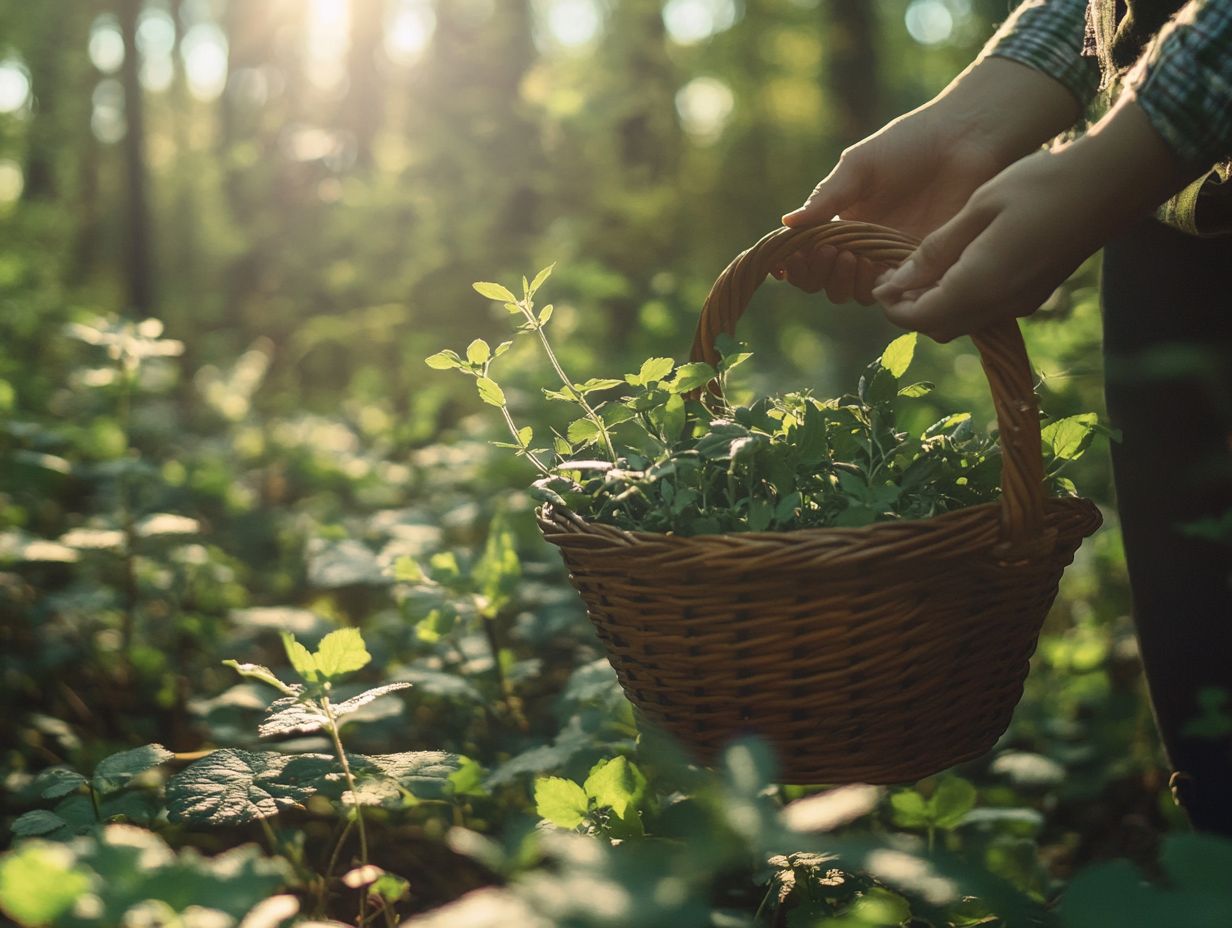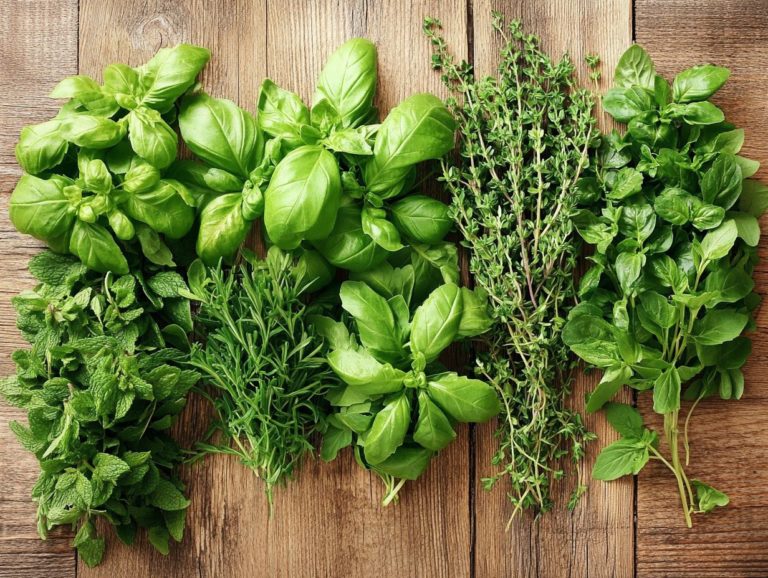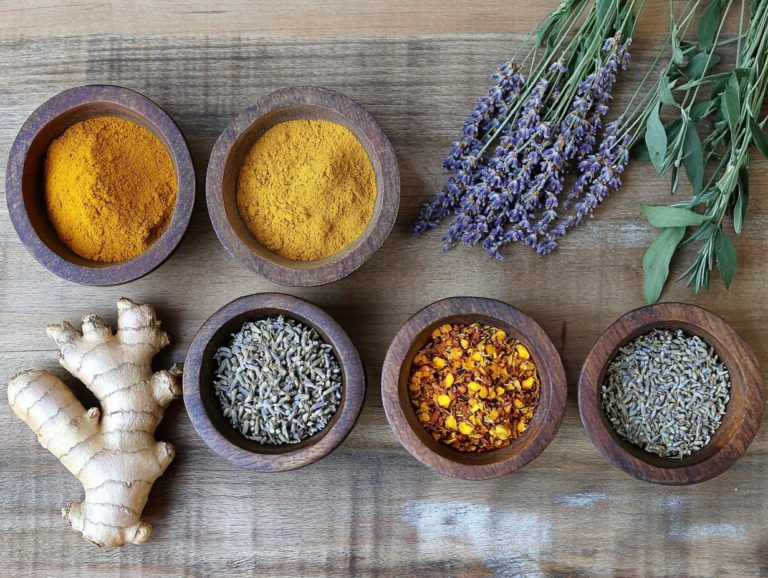The Art of Herbal Foraging
Herbal foraging is an ancient practice that beautifully connects you to nature. It offers an abundance of nutritional and medicinal benefits. Whether you’re looking to elevate your culinary skills or explore the healing properties of wild herbs, this guide will navigate you through the essentials.
From identifying and harvesting herbs to preparing and preserving them, you’ll uncover tools and techniques that make foraging not only accessible but truly rewarding. Important safety tips and ethical practices will help you ensure a responsible and sustainable experience.
Immerse yourself and unlock the secrets of nature s pharmacy!
Contents
Key Takeaways:

- Discover the powerful benefits of herbal foraging and how it can transform your health!
- Learn the essential skills to confidently identify and harvest herbs for a rewarding experience!
- Join the movement for sustainability by practicing ethical foraging techniques!
What is Herbal Foraging?
Herbal foraging is the art of gathering wild plants, herbs, and greens that serve not only as sustenance but also as powerful allies in natural healing. This sustainable practice invites you to connect deeply with your local flora while expanding your understanding of how people use plants.
Rooted in ancient traditions, herbal foraging carries immense cultural significance, passed down through generations. It involves the careful identification of plants that contribute to both nutrition and overall health and well-being. Many communities have turned to the timeless wisdom of herbalism, relying on nature’s remedies that often boast greater potency than cultivated alternatives.
Your foraging adventures encourage you to explore the intricate relationship between humans and the environment. Learning the language of plants transforms into a profoundly enriching experience. By embracing wild foods, you unlock a treasure trove of flavors and benefits, enhancing your culinary creativity while supporting your well-being through natural, unprocessed ingredients.
Benefits of Foraging for Herbs
Foraging for herbs presents you with a wealth of benefits, including access to highly nutritious plants, potential healing properties, and a chance to engage deeply with nature. As you immerse yourself in this practice, you may uncover a diverse array of wild foods that not only enhance your diet but also promote holistic well-being.
Adopting sustainable gathering methods deepens your understanding of local ecosystems while fostering connections within your community. Sharing knowledge and experiences in community gardens or herbal workshops enriches the journey, making it all the more rewarding.
Nutritional and Medicinal Benefits
Nutritional and medicinal benefits are at the forefront of herbal foraging, with many wild edibles brimming with vitamins, minerals, and antioxidants essential for your overall health. Plants like dandelion, goldenrod, and yarrow are not only delightful additions to your meals but also come packed with remarkable healing properties, making them invaluable components of herbal remedies.
Incorporating these nutritious plants into your meals or teas lets you access nature’s pharmacy. This elevates your journey to better health.
Beyond their culinary appeal, each of these plants offers a distinct array of beneficial properties. Take dandelion, for instance; it s lauded for its ability to support liver health and aid digestion. Then there s goldenrod, with its anti-inflammatory effects, perfect for brewing a soothing tea that provides respiratory relief. Yarrow is another gem, often utilized in poultices for wound healing.
For you, correctly identifying these plants is vital. Diving into extensive guides and participating in local workshops will dramatically expand your knowledge. By incorporating these wild plants into your recipes like a refreshing dandelion salad or a calming yarrow-infused tincture you can further enrich your diet with diversity and healthfulness.
Identifying and Harvesting Herbs

Get ready to dive into the exciting world of herbal foraging! Identifying and harvesting herbs is not just a skill; it s an adventure that connects you to nature’s treasures. It demands a harmonious blend of knowledge, skill, and deep respect for nature.
By employing the right foraging tools like field guides and plant identification apps you can significantly elevate your foraging experience.
Understanding harvesting ethics enables sustainable gathering methods. This ensures that wild plant populations flourish while you relish the benefits of wild edibles, whether from your own backyard or the untamed wilderness.
Tools and Techniques for Successful Foraging
Effective foraging demands the right tools and techniques. Essential tools you ll want to have include sharp knives, collection bags, and reliable field guides. These will assist you in accurately identifying wild edibles.
Engaging in herbal workshops can further equip you with the knowledge and skills necessary to navigate the foraging landscape safely and responsibly.
Using smartphone apps provides real-time identification support, seamlessly merging traditional methods with modern technology. By learning from seasoned foragers in community groups, you enhance your safety through shared experiences and deepen your understanding of the local ecosystems around you.
Taking part in hands-on learning opportunities, like guided foraging walks, allows you to identify edible plants in their natural settings. This boosts your confidence and competence.
Understanding the growth cycles and habitats of various plants enriches your foraging experience. It helps you make informed choices while cultivating a profound appreciation for nature s abundance.
Preparing and Preserving Foraged Herbs
Preparing and preserving foraged herbs is an essential process. It allows you to fully capitalize on your wild harvests, transforming them into herbal remedies and plant-based staples for everyday use.
By employing proper cleaning, drying, and storage techniques, you can retain the potency of your herbs. This ensures they can be enjoyed throughout the year in various forms, such as herbal teas and extracts made from herbs that can be used for health.
Mastering these methods will elevate your culinary practices and enrich your natural health journey, transforming your foraging efforts into a treasure trove of natural benefits.
Cleaning, Drying, and Storing Techniques
These techniques are essential for ensuring that your foraged herbs retain their vibrant flavors and medicinal properties for future use. Start with effective cleaning methods, which involve rinsing off dirt and pesky insects.
In terms of drying, you have several options: air drying, using a dehydrator, or even the oven. Proper storage in airtight containers is key to preventing moisture from sneaking in, allowing you to conveniently use them in herbal teas and remedies long after the harvest season has passed.
Each of these steps significantly enhances the longevity of your herbs. For instance, thorough cleaning not only eliminates contaminants but also prepares the plant material for further processing, minimizing the risk of spoilage. Air drying is ideal for delicate herbs, helping them retain their essential oils, while dehydrators and ovens offer quicker alternatives just be cautious to avoid overheating.
Once your herbs are adequately dried, store them in cool, dark places, preferably in glass or wooden containers. This shields them from light and humidity, both of which can degrade their valuable compounds. These meticulous techniques ensure that every sip of your herbal tea or extract delivers maximum therapeutic benefits, underscoring the importance of quality in your herbal remedies.
Safety Considerations for Herbal Foraging

Safety considerations for herbal foraging are crucial to ensure that you have a rewarding and secure experience while exploring the great outdoors. It’s essential to cultivate a sharp understanding of local flora to accurately identify and avoid poisonous plants that can easily be mistaken for their edible counterparts.
Be mindful of potentially contaminated areas, such as those near industrial sites or busy roads, to protect your health while you savor the countless benefits that nature has to offer.
Avoiding Poisonous Plants and Contaminated Areas
Avoiding poisonous plants and contaminated areas is essential for safe herbal foraging. It demands both knowledge and vigilance.
You should familiarize yourself with local toxic plants using comprehensive plant identification resources. This way, you can confidently distinguish harmful species from safe, edible options.
Stay sharp and aware of your surroundings to enjoy the thrill of foraging! Steering clear of areas suspected of contamination such as those near highways or industrial zones is crucial for minimizing health risks associated with foraging.
Certain regions are known to harbor specific poisonous plants, like the infamous hemlock in damp woodlands or the toxic water hemlock found in wetland areas. These plants can often be mistaken for harmless lookalikes, making thorough knowledge vital.
If you re exploring diverse terrains, it s imperative to recognize signs of contamination, such as unusual growth patterns or unpleasant odors.
Act quickly to avoid health risks! Consuming contaminated plants can result in serious health issues, ranging from gastrointestinal distress to severe toxic reactions. By remaining vigilant and well-informed about your surroundings, you can enjoy a safer and more rewarding experience in nature.
Ethical Foraging Practices
Ethical foraging practices are vital for maintaining the sustainability and health of wild plant populations. This approach allows you to savor nature’s bounty. By following harvesting ethics like taking only what you need and leaving enough for regeneration you engage in responsible foraging that honors the delicate balance of ecosystems.
Emphasizing eco-friendly practices nurtures a sense of community. Foragers like you can share knowledge and experiences, promoting sustainability through methods employed in community gardens.
Harvest Responsibly for a Sustainable Future
Responsible harvesting and sustainability are not just ideals; they are the very foundations of ethical foraging. This ensures you gather wild edibles in a way that supports the health of the ecosystem.
Embrace harvesting ethics that prioritize leaving some plants intact, allowing for natural regeneration and preventing overharvesting in specific areas.
By adopting eco-friendly practices, like using reusable bags and minimizing environmental disturbance, you contribute to the preservation of plant communities for generations to come.
This commitment to sustainability can also mean practicing selective foraging only taking mature plants while allowing younger ones to flourish. Being able to identify and avoid endangered species is essential for maintaining biodiversity.
Participating in community-led foraging workshops can greatly enhance your skills. Experienced foragers share invaluable knowledge about sustainable methods and the importance of ecosystem balance.
These collaborative efforts highlight the critical role you play in protecting wild habitats while savoring the abundant gifts that nature has to offer.
Frequently Asked Questions

What is the art of herbal foraging?
The art of herbal foraging is the practice of identifying, harvesting, and utilizing wild plants for their medicinal and culinary properties.
Why is herbal foraging important?
Herbal foraging allows us to connect with nature and utilize the healing properties of plants that have been used for centuries by our ancestors.
Conclusion
Get outside and start foraging responsibly! Join local foraging groups or workshops to enhance your skills and knowledge while enjoying the beauty of nature.
What are some basic guidelines for herbal foraging?
Some basic guidelines for herbal foraging include getting permission from landowners, correctly identifying plants, and harvesting in a way that allows the plants to thrive.
What are some popular herbs to forage for?
Get ready to discover popular herbs like dandelion, nettle, chamomile, and elderberry! Each offers unique flavors and benefits.
How do I properly harvest and store herbs?
When harvesting herbs, take only what you need. Leave enough for the plant to keep growing.
Herbs can be dried or preserved in oil or vinegar for later use.
Are there any safety precautions to keep in mind while foraging for herbs?
Yes, always identify plants correctly to stay safe. Avoid areas that may have been treated with pesticides.
It is also recommended to consult with a knowledgeable forager or herbalist before consuming any wild plants.






